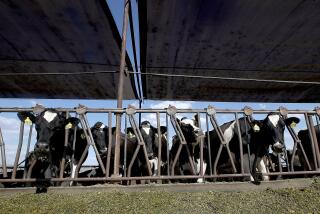Nurserymen Hustling : Loss to Avocado Crop Is Kept to Around 2%
- Share via
San Diego County avocado growers who braced themselves for an arctic chill last weekend found themselves instead plagued with a cure that in some cases killed the patient--strong winds that prevented frost damage but uprooted trees and blew tons of immature fruit to the ground.
Some area growers complained that more than half of their avocado crop was blown to the ground by the weekend’s high winds; a De Luz grower complained to county agriculture officials that he lost 85% of his fruit and leaves to the wind.
Countywide, however, only about 2% of the incoming Haas avocado crop--the industry’s main cash crop--was lost to the winds, estimated Warren Currier, executive secretary of the Escondido-based Avocado Growers Assn.
Coastal Area Hit Hardest
“The wind was most severe in the coastal area, running from Irvine down to San Marcos,” Currier said. Substantial wind damage to avocados was also reported in groves in Valley Center and Fallbrook as well as in Rancho California in southern Riverside County, while some groves--including those in the South County--escaped virtually unscathed.
Hardest hit were hillside groves exposed to the north and the east, agriculture officials said.
The wind was also blamed for blowing blossoms off some of the region’s young strawberry crop, and it created havoc for some North County greenhouse operations, which saw their plastic sheeting ripped off by the gusts.
Nurseries replace their plastic overhead sheetings annually and most growers had done that within the past month, Bill Snodgrass, assistant commissioner for the county’s Department of Agriculture.
Nurserymen were hustling Monday to replace the sheeting to protect their covered crops, including flowers and ornamentals that are especially susceptible to cold.
There were only isolated reports of frost damage to the region’s citrus, strawberry and avocado crops, Snodgrass said--thanks mainly to the high winds.
Temperatures generally did not fall below 28 degrees anywhere in the county, and then only for short periods of time, Snodgrass and growers reported. Most areas did not report temperatures below 30. They credited the wind for stirring up the cold air with warmer air, but that wind was a mixed blessing.
“From looking at some of the groves, it blew like hell,” said David Rahn, general manager of Giumarra Co., which controls about 2,000 acres of groves in San Diego County.
Salvaging Downed Fruit
“We’re picking up all the 8-ounce and larger fruit, and we’ll pack it as No. 2 (grade) because it will be scarred,” Rahn said. “It’s not worth going through all the salvageable fruit to see what can be No. 1 (premium grade). So what we pick up off the ground will either go to restaurants for guacamole or will go to customers in Mexico.”
Others agreed with Rahn’s assessment that while some groves were hard hit, damage overall would not affect the industry--or the retail price.
“Looking at the industry as a whole, I’d be surprised if we had more than 2% of the crop hit,” estimated Currier of the Avocado Growers Assn., based on reports he had received from owners and managers of large groves. “But some individual growers had up to 60% and 70% of their crop down, and even entire trees destroyed.”
Currier said that of the estimated 8 million pounds of avocados blown off the trees in Southern California, about 3 million could be picked up off the ground and salvaged for sale as lesser grade.
Harvesting of the Haas variety avocados had just begun in some groves, and most of the fruit blown to the ground was too immature to otherwise have been picked, he said.
A spokesman for Oceanview Farms in Oceanside said damage to his strawberry crop was minor and that his early crop will be ready for picking by Christmas, virtually unaffected by the weekend’s winds.
“Actually, the wind saved us from what we were most worried about--the frost,” the spokesman said.
More to Read
Inside the business of entertainment
The Wide Shot brings you news, analysis and insights on everything from streaming wars to production — and what it all means for the future.
You may occasionally receive promotional content from the Los Angeles Times.










